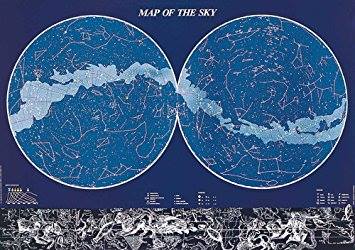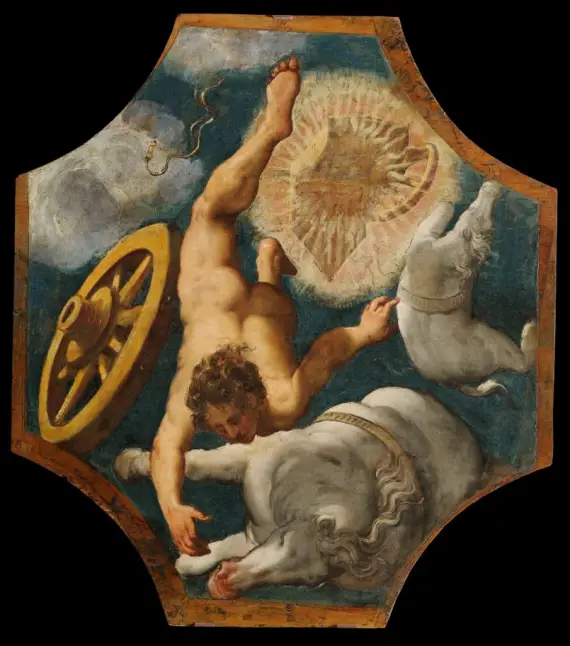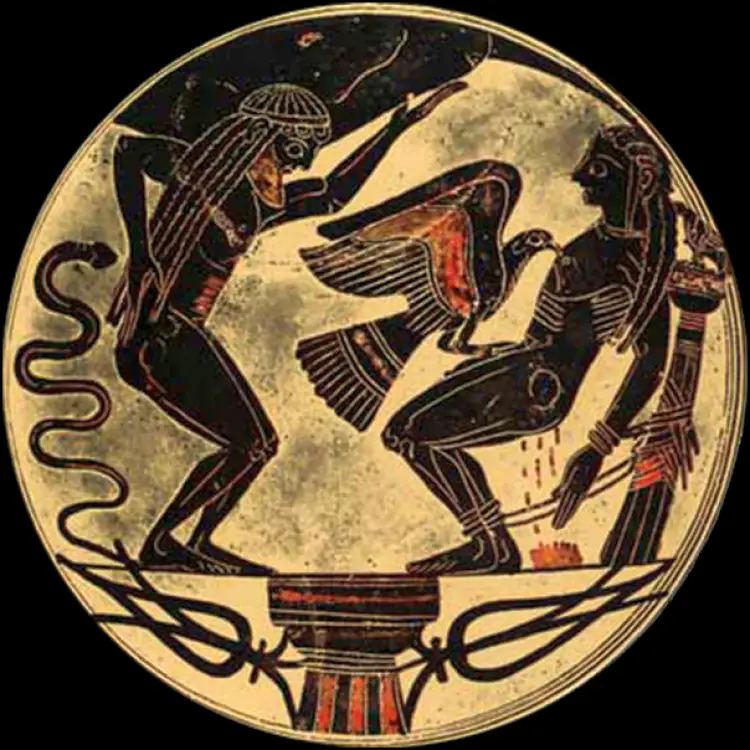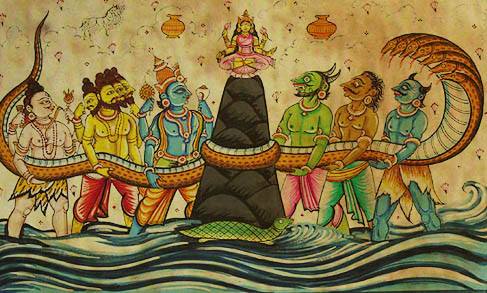di Andrew Casella
cover: Jean Delville, Prometheus, 1907)
[Continued from The astronomical significance of the Golden Age: Astrea and the "fall" of Phaeton]
In a Mongolian wedding prayer it is stated that: "Fire was born when Heaven and Earth separated": Therefore, before the celestial equator (Father Heaven) and the ecliptic (mother Earth) moved away (ie the inclination angle of about 23 ° of the ecliptic with respect to the equator was recorded), the" Fire " did not exist. At the beginning, the Milky Way united heaven, earth and the world of the dead: the southern part of the Galaxy, in correspondence with Scorpio and Sagittarius, is, for many traditions, the place dedicated to the collection of souls waiting to reincarnate.
Thus Plato in Republic:
"All the groups of souls, after having spent seven days in the meadow, had to get up at the eighth and leave from there, to arrive after four days in a place from where they could see, stretched from above all over the sky and the earth, a light as straight as a column, very similar to the rainbow, but brighter and purer. After a day of walking they arrived there and saw in the center of the light the ends of the chains hanging from the sky; this light in fact held the sky together and embraced its entire orbit like the ropes that wrap the keel of a trireme."
The latter could be a veiled allusion, in Plato's usual imaginative and reticent language, to the fact that the Southern Galaxy passes through the constellations of Carina, Stern and Vela, which together form the ship of Argos, whose rudder is Canopus. [1].
Instead, we point out that Santillana and Dechend reconnect the image to the ether which, according to the Pythagorean Philolaus, who calls it "the Whole", is the "cargo ship of the sphere": the Milky Way would then bundle this "cargo ship" , wrapping the firmament all around]. However, when the equinoctial colure moved from it, the "Fire" burned the earth separating it from the sky and the land of the dead. Then Heaven and Earth were founded: Time began to flow. Only Kronos had been able to reign over the three worlds at the same time [cf. Apollo / Kronos in exile: Ogygia, the Dragon, the "fall"].

It is worth noting that the Kronos mentioned above is not just an ancestral icon or little more than a symbolic reference: he is in effect Kronos-Saturn, astral power and soul of the seventh planet. A connection between the Golden Age and the planet Saturn is found in the sevenfold scanning of the mythical history of the Persians. In the Bahman-yast (I, 3) a seven-branched cosmic tree (gold, silver, bronze, copper, tin, steel and a "mixture of iron") is described, symbolizing the succession of the mythical ages under the aegis of the seven planets, a clear result of the influence of Babylonian astrology [cf. Cyclical time and linear time: Kronos / Shiva, the "Time that devours everything"].
Tradition says that Zeus, after having electrocuted Phaeton, catasterized him (that is, he transformed him into a constellation, as he often happened to do) and with him also Eridanus. The first, in the northern sky, became the constellation of Auriga, the other, in the southern sky, became Eridanus (which "gushes" from the foot of Orion, that is Rigel [in Arabic, in fact, “foot”]). All of these stars are on the same median that also contains Taurus, the new equinoctial point after the end of the Age of Gemini. As already mentioned, when precession changes it skhamba-armillary-cosmic-sphere, all reference points must move [cf. Stellar symbolism and solar symbolism].

Eridanus is associated with the star Canopus (α Carinae), since it is found to be the rudder-oar of Argos, the ship (made with the wood of the oak of Dodona [more trees and waters, one might say], sacred to Zeus) which, according to Apollonius Rhodium, sailed the waters of 'Eridanus. Here the Argonauts could still smell the burning smell of Phaeton's body burned by lightning. Were that not enough, Canopus is also the celestial counterpoint of Eridu, that is the seat of the Sumerian-Babylonian god, Enki-Ea [cf. Divinity of the Underworld, the Afterlife and the Mysteries]. And it is particularly interesting that Enki-Ea is called "Lord of the Abyss" or, more precisely, (Ananda K. Coomaraswamy, Khwāja Khadir is the source of life, in the tradition of Persian and Mughal art) "Lord of the Watery Depths".
Canopus is the brightest star in the southern hemisphere, i.e. the hemisphere of waters. Here there are both the underworld and the (so to speak) Elysian Fields, and we cannot fail to notice that Zeus transformed the sisters of Phaeton, abandoned themselves to an inconsolable funeral weeping, into poplars, placing them along the river Eridanus, whose homonymous constellation it actually looks like a long river. In various Orphic fragments reference is made to two poplars, one white, one black, at the entrance to Hades, and two sources, one of which absolutely must not be quenched. Graves (The Greek myths, Postal Code. 31) reports that the entrance to Tartarus is found in a wood of white poplars near the Ocean river.
Now, as already mentioned, "Ocean" (of which the Styx is only a branch, "the tenth part", according to Hesiod), according to Catasterisms of Eratosthenes, is also another name of Eridanus. In this region the Titans would have been precipitated by Zeus together with Kronos, the mythical fallen ruler of the Golden Age. According to Plutarch's version (De facie in orbe lunae), Kronos would have fallen into an invincible sleep "In a cave deep inside a gold-colored rock" placed on an island called Ogigia [cfr. Apollo / Kronos in exile: Ogygia, the Dragon, the "fall"]. Ωγύγιος, "ogigio", is a classic epithet of the river Styx (see the Hesiodic expression Στυγός ύδωρ ωγύγιον, rendered as "the water primordial dello Styx "in Greek - Italian vocabulary, Loescher 2003, p. 2282). Pierre Grimal (cf. Encyclopedia of myths, Garzanti, 1990 p. 579), based on the Hesiodic version, under the heading "Styx" reports:
“When a god wanted to bind himself with an oath, Zeus invited Iris to draw a pitcher of water from the Styx and brought it back to Olympus, so that he could be a 'witness' of the oath. If the god later did not keep the oath, a terrible punishment awaited him. He remained breathless [κώμα] for a whole year and did not bring either ambrosia or nectar to his lips. At the end of that year, another test was imposed on him. For nine years, he was kept segregated from the ever-living gods and attended neither their councils nor their feasts. He did not regain possession of his prerogatives until the tenth year. This description of the effects of perjury [...] it also offers details on the nature of this fatal water. It consists, we are told, in an arm of the ocean, exactly the tenth part of the initial river, and with the other nine forms the nine coils with which the river surrounds the disc of the earth. This figure of nine coils is found in the Virgilian description of the infernal Styx, which surrounds the kingdom of the Underworld with its meanders ".
The author does not understand the significance of this news, but we can try a conclusion. So what is Ocean and what is Styx? They are certainly asterisms of the southern sky, and not ordinary rivers. As we mentioned in the third part, the water of the Styx, which induces in the gods a swoon similar to death (κώμα), reveals unsuspected links with Avestian Haoma. Note that the ancient Chinese and Aztecs also believed in a hell crossed by nine rivers.
In Ogygia, Kronos would rest until his next coming, but, despite being asleep, he continues to distribute the "measures" to his son Zeus, another who, according to Aeschylus (Prometheus chained), sooner or later he will have to be thrown off the celestial throne [2]. According to a tradition defined as "obscure" by Pierre Grimal (cf. Encyclopedia of myths cit. p. 455), Ogigo (Ώγυγος) was also the name attributed to the “king of the Titans”, who was conquered by Zeus at the same time as his subjects.
All these catasterisms have a meaning, since from a certain point forward the Galaxy could no longer function as an "open way" that connected the earth to heaven and the underworld: due to the precession of the equinoxes, the equinoctial colure had moved so far from by now being disconnected from that ancient visible axis [cf. Cyclic time and its mythological meaning: the precession of the equinoxes and the tetramorph]. The doors had closed, as echoes the Norse fragment referring to the wrath of Fenrir, which we quoted: even there the gnomes no longer find the doors to their underground dwellings. It was then the task of Auriga, to the north, and Eridano, to the south, to inherit the ancient connective function of the Milky Way. This function, however, could only be performed "intermittently", since from that time on the entrance to the heavens was suspended in the air, while the entrance to the kingdom of the dead had moved "under the sea" .
Santillana and Dechend (Hamlet's mill, pp. 304 - 305) identify the mythological reason for the displacement of the equinoctial colure on the Auriga-Eridanus axis in two Orphic fragments, handed down by Proclus. The first says that Demeter separated the food of the gods, dividing it into a solid and a liquid part, nectar and ragweed. The second declares that, after giving birth to Zeus, Rhea became Demeter. Now, the main star of the Auriga constellation is Capella (α Aurigae), the Capretta. It depicts Amalthea, the goat who was the nurse of Zeus, hidden by Rhea in the cave of Mount Ida, far from the gaze of Kronos. The horn of Capella / Amalthea, which the infant Zeus broke while playing, was for the immortals the Cornucopia, the source of nectar and ragweed. It seems quite possible, therefore, to hypothesize that the advent of Demeter (formerly Rhea), with her separation of the divine food, refers to the decisive shift of the equinoctial color on the celestial axis of Capella.

To establish this again skhamba it was necessary to obtain the "measures", or the "fire". When the "visible" coluro moved from the Milky Way at the end of the Golden Age, it was necessary to go in search of the tools to identify its new position. According to the Sumerian tradition, it was Gilgamesh who drew the me (the measures) from Eridu / Canopus, while the Greek myth assigns the task of stealing fire to Prometheus (the Hindu Pramantha). Now, according to tradition, this Titan also passes for being the inventor of numbers. But if the notion of number comes from heaven, as we illustrated at the beginning, it is very easy to guess where all this leads.
Prometheus went to the "seat of the Ṛta", Eridu / Canopus, and drew from it the "fire", the longitude coordinates of the new skhamba, giving it to men. In an Orphic hymn Prometheus is expressly called Kronos. And this is understandable, if the seat of Ṛta is the southern pole of the ecliptic, "seat of immortality" [cf. Apollo / Kronos in exile: Ogygia, the Dragon, the "fall"] escaping the precessional motion and therefore can be taken as a sure point of reference for the establishment of the changed celestial coordinates of the skhamba-armillary-cosmic-sphere. The myth says that Prometheus hid the fire inside a reed. Similarly, Tezcatlipoca is said to have drilled fire into the sky in the year "2acatl", ie "2canne". Remarkable, then, that the Sumerian word for "cane" is gi, “To burn” and Gibil (who “grew up in the pure apsu”, That is, in the abyss) is the god of Fire.

The inclination of the ecliptic with respect to the celestial equator is instead echoed in India by the episode of the "Churning of the Ocean of Milk", carried out to obtain theamrita (Hindu ragweed). The two opposing forces that allow you to turn the churn (the celestial equator and the ecliptic) are represented, respectively, by the Devas (the celestials) and the Asuras (beings who were once good, who later became demons). In several Egyptian friezes, very similar scenes can be observed, where Horus and Set (the celestial god and the donkey-headed demon, like the Asuras) are intent on "drilling" an agricultural tool or turning a churn.
Typhoon / Set, whose soul was called "Bear" by the Egyptians, represents an aspect of the extreme mobility of the ecliptic and is linked to the name that the Pythagoreans gave to the two Bears, namely "Hands of Rhea", the two true and own handles that turn the sphere of the firmament. Compared to Osiris (or his hypostasis, Horus), Set represents the action of the opposite force of the ecliptic necessary to turn the wheel. From this moment on there will be no more union of heaven and earth, but each one will continue on its own motion (in truth the equator is fixed, while the ecliptic is mobile), and the reciprocal inclination will cause the river to flow. weather. The Golden Age ends at this time.

Note:
- Writes Plutarch (Isis and Osiris par. 22): "Furthermore [the Egyptians] they call Osiris chief of armies, and helmsman Canopus, who was transformed, they say, into the star that bears his name. The ship that the Greeks call Argos is considered to be the image of the ship of Osiris, and placed among the constellations in honor of him. Its path is not far from that of Orion and that of the Dog, which the Egyptians consider respectively sacred to Horus and Isis ”. One should not give too much weight to the fact that Orion is here identified with Horus, rather than with Osiris. Horus is but a hypostasis of Osiris.
- The tortures inflicted on Prometheus (the Titan behind whose tragic mask Kronos himself is hidden) to induce him to confess the prophecy that is believed inside about the future end of the reign of Zeus are useless. Scornful, Prometheus declares that he is willing to die, rather than reveal it to the one who has reserved such an atrocious fate for him on the summit of the Caucasus (and for what? For stealing, coincidentally, the "fire"). In the epilogue, Prometheus ends up buried under the collapse of the mountain caused by Zeus. But what, then, is this Caucasus? The mountain that ruins him appears to be another version of Kronos's “exiodintartaramento” operation. A few verses earlier, Hermes, a heavenly envoy, warns Prometheus that his obstinacy will cost him dearly. He predicts that he will be buried under the mountain and that his limbs will lie like this for an indefinite number of eras, until Zeus resurrects him and places an eagle at his side (defined as "Zeus's dog") which will devour him. the liver: and this "hell" will never end “If any of the gods does not show himself and assume / your pains, what to blind Hades, and Tartarus / in the dark abysses elect to descend ". Disconcerting and dizzying change of set, to say the least. On the other hand, in the end, the prophecy "dies" with Prometheus, who actually ends up hit by the landslide, with a sharp and appealing image that evokes the"Until the sea was closed over us" of the last verse of Dante's chant dedicated to the "Promethean" Ulysses. In any case, that Zeus was also subjected to a schedule comes to us indirectly from Pythagoras (cf. Porphyry, Life of Pythagoras par. 17): "Set foot in Crete, he frequented the initiates of Morgo, one of the Dactyls of Mount Ida, from whom he was also purified with the stone of lightning [?], at dawn lying face down by the sea, at night crowned by a river with the fleeces of a black ram. Descended into the cave called Idea with black wool, he remained there three times the nine days prescribed and sacrificed to Zeus and saw the throne sprinkled every year with leaves in his honor and engraved an epigram on the tomb entitled 'Pythagoras to Zeus', the beginning of which says : 'Here lies Zas dead, whom they usually call Zeus' ”. So also Zeus (the Zas of Ferecides) had already passed away, at the time of Pythagoras? Did Prometheus' prophecy have a cosmological sense? Olympiodorus (Comment on Fedone, 61 c) has left us an Orphic news according to which the present times would be placed under the empire of Dionysus. Dionysus would in fact be the ruler of the last era, after Uranus, Kronos (Olympiodorus writes precisely Chronos) and Zeus. There is a strong suspicion that Uranus, Kronos, Zeus and Dionysus are none other than the sky, or each an aspect of the sky according to the turning of the astrological eras, starting from the Golden Age.
Bibliography:
- Ananda K. Coomaraswamy: Khwāja Khadir is the source of life, in the tradition of Persian and Mughal art, in What is Civilization and other essaysGolgonooza Press 1989
- Aeschylus: Prometheus chained, BU 2004
- Robert Graves: The Greek myths, Longanesi 1963
- Pierre Grimal: Encyclopedia of myths, Garzanti 1990
- Alessandro Lami (edited by): The Presocratics, BU 2016
- Plato: Timaeus, BU 2014
- Plutarch: Isis and Osiris, Adelphi 1985
- Porphyry: Life of PythagorasRusconi 1998
- George de Santillana: Ancient fate and modern fate, Adelphi 1985
- Giorgio de Santillana and Hertha von Dechend: Hamlet's mill, Adelphi 2003

7 comments on “The "Heavenly Fire": Kronos, Phaeton, Prometheus"